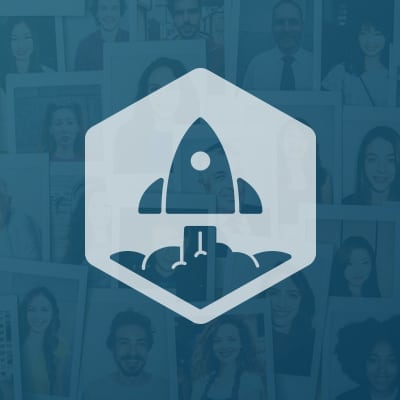In this talk with Byron Deeter and Kristina Shen of Bessemer Venture Partners, we get an illuminating glimpse into the state of the cloud for 2017-2018. They run through what 2016 was like – M&As were at a record high; IPOs were at a record low – and let companies know what they should know if they want to kill it in the next year.
One of the most interesting takeaways was that AI and voice are on the rise. More and more we’ll even see graphical user interfaces being taken out of the equation (i.e. screenless software). Another prediction they make is that NPS will still reign as king for customer success.
As we know, things change quite quickly in the SaaS world but one prediction remained the same since last year: having diversity in your team is as important as it’s ever been.
You can see the slide deck here.
And if you haven’t heard: SaaStr Annual will be back in 2018, bigger and better than ever! Join 20,000 fellow founders, investors and execs for 3 days of unparalleled networking and epic learnings from SaaS legends like Jyoti Bansal, Aaron Levie, Josh James, and Dustin Moskovitz. If you don’t have tickets, lock in Early Bird pricing today and bring your team from just $499! Get tickets here.
Transcript
Host: You checked the Bessemer Cloud Index daily. After more than 100 cloud investments and dozens of IPOs, no one knows cloud better than Bessemer Venture Partners. Please welcome the authors of “The State of the Cloud,” Byron Deeter and Kristina Shen.
Byron Deeter: Howdy, SaaStr peeps.
Kristina Shen: Hi, everyone.
Byron: It is great to be back here on the SaaStr stage. In the next 20 or so minutes, we’re going to endeavor to do a bunch of things. We’re going to try to talk about where we’ve been and what happened over last year, where we’re at, and then where we think we’re headed.
I’m going to start off as a warm up act and then Kristina’s going to bring it home as we dive in. We’re going to start off by setting the stage a little bit over the last year in particular. 2016, the word that came to mind was Wowza because it was a heck of a year in many regards.
Let’s start with the geeky tech side of it in all of us. One of the things that we love at Bessemer is the harder sciences. Right now, there is at least a dozen companies putting collectively billions of dollars into software and intelligence around autonomous vehicles that’s starting to push the envelope in terms of what software means and harder software and softer hardware as they start to converge.
The public market’s a little bit of a heartbeat in particular with some very noticeable and strong companies were able to get out. We were proud backers of Twilio, which was the largest cloud IPO of last year.
Our friend up in the Pacific Northwest, Jeff Bezos, made it rain as AWS revealed their numbers for the first time. Billions in net income, not to mention breaking through the $12 billion run rate mark in ARR in what proved to be one of the most powerful cloud businesses we’ve yet to see in the world.
Let’s not forget our friends down on the peninsula, also another proud Bessemer portfolio company, LinkedIn, where they decided 26 billion felt about right. Satya and team acquired LinkedIn in what was not only the biggest acquisition of the year, but actually the biggest software acquisition in software history.
At a high level, there was a lot of excitement laying the groundwork for all of you and where we’re at today in 2017. Actually, if you were a public company at this time last year and when I stood before you on the stage, this is actually where we were at. The market was down 35 percent in just a few weeks.
For the newly minted public unicorns, 350 million or so of your market cap had disappeared just in the start of the year. There’s a lot of anxiety and uncertainty in terms of where we’re at and what’s ahead.
Roll forward the clock to how the year played out, we made up not only all of that ground, but actually ended 15 percent higher in aggregate in the cloud space. If you pull back a little bit more, this is the BVP Cloud Index, you see that this is actually one of the few bumps along the way of what has been a pretty awesome but highly volatile journey.
To get alpha, you accept a little more beta, is how we think of it. But how you think of it, there’s three dramatic results from this in terms of how 2016 played out, that were direct causal factors from this volatility that you saw.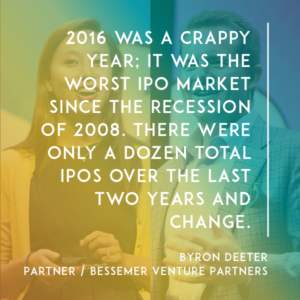
The first was in the IPO market, a crappy year all in, the worst IPO market since the recession of 2008. If you look across the cloud landscape, only the bravest and some would say the best companies, managed to get out, a dozen total IPO’s over the last two years and change, that’s it. Record low tech IPO’s, and for the explosive part of technology, in which we all live and play, this cloud ecosystem, only a dozen.
Now, at Bessemer, we’re fortunate to work with 40 percent of these, and more than our fair share of the largest, and so that’s the perspective that’s going to inform the rest of the discussion today. When we talk about this ecosystem, we’re going to talk about the winners. We’re going to talk about those that have gotten public. We’re going to talk about the private unicorns and what that means to all of you.
The second major result from last year was M&A. We talked about LinkedIn, but even stripping out that 26 billion, it was a record year in every way. Add it back in, 4x more than any other year. $60 billion of M&A activity last year because there was a hiccup in the stock prices, there was a window of opportunity for the legacy vendors to finally buy in at what felt like slightly depressed prices, and they pounced.
If you look at the lineup and go through the 80 or so public companies over the last eight years, the $300 billion of market cap, this is what it looks like today. Over 40 percent of the value of the public cloud companies has been acquired away.
Strip out sales force at the top there, and well over 50 percent has been acquired. That’s awesome news for all of you, and it’s awesome news for us as investors because this is what the ecosystem looks like.
Yes, there’s $180 billion in public cloud companies remaining. $129 billion of which was acquired, but it’s what’s below the surface. Use the analogy of the tree, and seasons have come, and apples have been picked, or whatever. It’s the strong foundation. It’s a strong trunk. It’s the smaller companies that aren’t yet visible to the world that are going to drive innovation and that are changing the cloud ecosystem, and from our perspective, the tech world.
For the first time last year, we actually partnered with Forbes Magazine and put together the Forbes Cloud 100. So Bessemer and Forbes put together a big event. They dedicated well over a dozen pages in one of their issues for this list, a cover story, etc. We pulled together the top 100 private cloud companies, which in aggregate represented over $100 billion in market value. Here’s a handful of them and there are dozens more.
This is the quality that’s lying below the surface right now. This is the quality that is in this room and represents what we believe is the next wave of great cloud success. The next question we get a lot is, “That’s great. How can I be like them? What is the path for success? What should I, as a founder, CEO, early executive team member, be doing to get on this path to public company status, private company unicorn status where I control my own destiny, and ultimately, success?”
Kristina’s going to break it down for you in the three most common questions we get and our recommended answers.
Kristina: Thank you, Byron. Thanks so much for having me here today. I’m excited to be here.
We had a wide range of questions from CEOs all the time. We wanted to hone in on the three main questions that top private CEOs ask. That is, “How fast should I be growing and how does that evolve overtime? How much should I burn and how do I trade off between growth and profitability? How do I scale because it’s pretty daunting to be a 10 person startup, then suddenly a 100 person startup?”
Let’s dive right in. How fast should I be growing? This is an actual email that I got a couple of weeks ago. The entrepreneur’s probably sitting in this room and really laughing that this is on stage right now. He asked, “How long does it take to get to 10 million ARR? What does the data say? What’s good? What’s better? What’s’ best?”
I decided, “All right. As a data nerd, I’m going to dive into this.” The first thing I do is I start Googling like crazy to find an answer online. The first thing I came across is Dropbox last week announced they are the fastest SaaS company to get to $1 billion in run rate revenue. It’s eight years to $1 billion. I’m like, “Wow. Is this the new growth standard? That is incredibly fast.”
The truth is, that’s probably really, really fast. They are a top tier decacorn company. There’s probably the next Dropbox in this room. I thought, “OK.” For people in this room, let’s say you’re at $1 million in ARR. To drag your excel formula to $1 billion in revenue is probably pretty daunting. Let’s take a step back and make this a little bit more tangible.
Let’s look at how do the top cloud companies perform from $1 to $10 million in ARR. Here, we showed Twilio, Instructure, Box, and Shopify, all very successful public companies. Thankfully all to be Bessemer funded portfolio companies as well, and how long it took for them to get to $10 million ARR? You see, Twilio got there pretty quickly. They got there in about one year. Shopify took two and a half years, but it’s a $3 billion public company. There’s multiple paths to success.
Just for fun, we’ll look at Slack, who got there in just a couple months. What about from $1 to $100 million in ARR? How long does that take? Here, you can see it’s a broad spectrum again. Slack got there very, very quickly, two and a half years. Blackline took a little longer and got there in 13 years.
These are all billion dollar companies. All successful cases that show that whatever growth trajectory you’re on, you can create value in multiple ways and create a lot of equity value for yourselves and for your investors.
What do all the public companies look like? We mapped the 43 top cloud companies out there and looked at the top, median and bottom quartile. We saw that the top quartile gets from $1 to $100 million in just five years, the median in seven, and the bottom quartile in just over 10.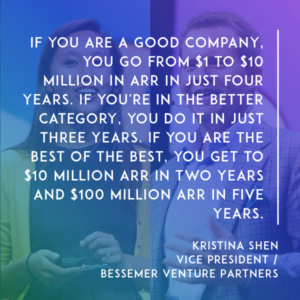
The question begs, what does this mean for all of you? According to the BVP growth benchmarks, we mapped good, better, best to the bottom, medium, and top quartiles of the public companies. What does it say? If you are a good company, you got from $1 to $10 million in ARR in just four years.
That means you did a little better than a double, double, double, double and you’re on the same growth trajectories as companies like Cornerstone and Mindbody.
If you’re in the better category, you did it in just three years. You did a triple double, double and you’re in the same growth trajectory as companies like HubSpot and Coupa. If you are the best of the best, you got to $10 million ARR in two years and $100 million ARR in five years. You’re in the same class as companies like Twilio, Box, and Workday.
The great news is whatever category you’re in, there are multibillion dollar companies in all three of these categories. There’s not one single formula or growth trajectory, but there’s multiple ways to be successful. Hopefully this helps you think through and map through your growth trajectory as you continue to plan your futures.
Let’s jump to the second question. How much should I burn? I’m sure many of you went through 2017 planning just recently. This is probably top of mind, “Do I spend on those five extra sales reps this quarter and next quarter, or should I drive that pretty top line growth?”
To dive into this, let us first define what we call the efficiency score. To talk about this, many of you know the rule of 40. It’s a simple rule. It basically says, “Your annual revenue growth plus your profit margins should be 40 or greater to be considered a good company.”
We’re going to change it up a little bit. We’re going to define the efficiency score. What that is is your CARR growth plus your percent burn, percent burn being basically your free cash flow margin. That’s because we want it to be a true representation of what your sales team is selling, the cash you collect, and what you reinvest back into the business.
The major change we’re going to say that’s wrong about the rule of 40, it’s directionally correct, but we’re going to change it up a bit, is that we’re now going to say 40 is the right number. We’re going to make an argument. It’s actually a cascading scale. We’ll talk a little bit more about this throughout the presentation.
There are multiple models of success for efficient growth. Here are just two with Shopify and Veeva right before they went public. You can see Shopify is a great example of a growth driven efficient model. They were growing very quickly, 112 percent before they went public. Their efficiency score’s driven heavily by their high growth.
Veeva is a free cash flow driven model. While they were still growing quite quickly at IPO, they were actually extremely free cash flow positive and that’s really what’s bumping up their efficiency score. The markets reward this. Both are trading at close to 10 times revenue.
What’s most interesting is that companies at different stages have different efficiency scores. Here, we’re showing the public companies and their average efficiency score pre and post IPO. Three years pre IPO, the average efficiency score is 73 percent. Three years post IPO the average efficiency score is 32 percent.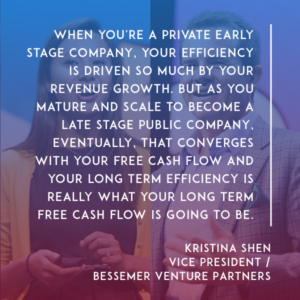
When you’re a private early stage company, your efficiency is driven so much by your revenue growth. As you mature and scale to become a late stage public company, eventually, that converges with your free cash flow and your long term efficiency is really what your long term free cash flow is going to be.
What does that mean? What does that mean for everybody in the room? Well, as always, we like to develop frameworks, so here’s another framework. The BVP efficiency rule says, “If you’re greater than $30 million in revenue, you just have to remember three numbers, 70, 50, 30.”
That’s because when you’re expansion stage company and you’ll call it at $30 to $60 million in ARR, 40 is actually too low of a bar for you. You should be aiming for 70 percent efficiency score. If you’re an IPO company and $100 million in revenue, you should be targeting 50 percent. If you’re a public company over $150 million revenue, you should be targeting 30 percent.
What about companies who are less than $30 million ARR? What’s your benchmark? We recommend you look at what is your net new ARR relative to your net cash burn. That ratio should be greater than one. A simple example is you grow from $10 million ARR to $25 and you burn $10 million in the meantime, you have a 1.5 extra efficiency score, which we would say is very efficient. Hopefully, you can think through these tradeoffs as you think through growth versus profitability.
The final section I’ll talk about is, “How do I scale?” For a cloud company, this really comes down to, “How do I scale go to market? How do I scale my sales in marketing?” You all have seen this equation. It’s our CAC payback calculation. What really matters though is less the formula, but what goes into the formula, they interchange between the different items. We think about the inputs as our delicious CAC cocktail formula.
People ask us all the time, “What is the perfect sales model? How many AEs should I have? What’s the ratio to SDRs? What’s the quota?” You can see some light benchmarking on the right. While these metrics are very important and you should track all of them, what’s so much more important is the interplay between these metrics.
We bucket all of these metrics into three core inputs, which is sales rep productivity, marketing spend, and sales support. Roughly, what we have seen from companies is this tends to be a third, a third, a third of your total spend. That changes based off your customer base.
If you’re selling into the enterprise and have a massive field sales team, it’s pretty common for your marketing spend to be less than a third. If you’ve got a freemium model and you’re driving huge inbound leads, it’s actually pretty common for your marketing spend to be upwards of two thirds of that spend.
There’s no perfect sales model. What really matters is understanding your sales model and finding the right model that fits your business and customer base. We talk so much about 12 month CAC payback as the right benchmark for everybody. That very much is true for that middle category.
If you are a mid market company, 12 months probably is your right number. But if you’re selling to the enterprise and you’ve got 100K ACV deals, you’re driving great upsell, you should think of everything as an LTV to CAC ratio. If you’ve got a higher LTV, you can spend more to acquire customers. Your CAC payback might be upwards of 18 to 24.
On the flip side, if you’re selling into SMBs and you’ve got a lower ACV and you’ve got higher churn, you have a lower LTV until you must spend appropriately. Your CAC payback might be closer to three to six months.
There’s multiple models of being successful. Here, we walk through a simple example of what are the tradeoffs between your CAC payback and your retention and upsell. Here with two very different companies, you can actually drive to the same cash flow business in year four. Hopefully, this helps frame up how you think about go to market. Really, there’s no one right sales model. It depends on what’s right for your business.
Now, we’ve walked you through our frameworks for growth, burn, and go to market. Hopefully, you can use these frameworks in your day to day lives. Hopefully, they help you think through tradeoffs and opportunities as you continue to run your businesses.
Next, I’m going to hand it off the Byron to talk about our predictions for this year.
Byron: All right. A round of applause for Kristina. Thank you.
[applause]
Byron: We’ve laid the groundwork in terms of where we’re at, the 2016 review, the state of the financial markets today in ’17. We’ve talked about the operational imperatives, the three primary questions that you’re probably asking your exec team, having in your board discussions, etc.
Now, we’re going to attempt to go a little bit ahead, literally and figuratively the road ahead with some of our predictions of the things, strategically, that our executives and founders are thinking a lot about.
We’re going to build on this idea of the AI notion as we go into number one here which is that, one foundational part of the AI approach we think is wrong which is that, literally, in this case, a lot of the effort has been around avoiding humans. In this case, the point cloud and the virtual display of avoiding pedestrians.
Also figuratively, the idea of how do you take humans out of the process. How do you reduce work, but in many cases, alleviate the need for human entirely?
However, we actually think this is the state of AI today, which is the Uber car on the side of the road, the Volvo on the side of the street running out of gas because they forgot to instrument the gas gauge for the self driving part of automation. The human here is doing the walk of shame with the gas tank filling up a car because they forgot this important step.
That’s actually the state of AI today which is this interplay. This mutual dependency where the power of compute, the power of smart software starting to reveal itself in awesome ways, but there’s this inter dependency, in fact, this complementarity, by making humans better. That’s where we’re seeing it first.
Prediction one is that this year, and in the coming few years, will be the era of the human assisted AI. Take the most valuable knowledge workers, the high wage employees across your customer base and figure out how to help them. Figure out how to take, in the security industry, the thousands of signals that are getting in waved through that and expose the issues for human resolution.
That’s where in the early days, AI will make a difference. Related to that in terms of building product is the other edge of smart construction of smart software. That’s number two. That’s where APIs come into play. We have this fantastic gift of wonderful software and services available in the market today.
Virtually, any foundational infrastructure need can be delivered via someone else that’s doing that as a dedicated business. If you’re not leveraging those like crazy, you need to go to your engineering team, you need to ask your CTO, your head of engineering, your co founder, in many cases, why not?
Because nine times out of 10, this will be better, faster and cheaper than your internal team can build, and they’re getting in the way of you building the high value layer on top of it. That’s the foundational layer. Because there’s infinite resources available, almost literally in the case of infrastructure as a service, you can’t put infinite cost against it.
That’s feeds into law number three. Our prediction for this year which is that, architecture in success is architecting for success. It’s planning ahead with a resource dependent world where a zero sum game is still at play in terms of your dollars you can spend. It’s fabulous to be able to leverage this compute clouds and resources out there.
More and more of our companies that are getting ready to go public will come to us and say, “Wow, we just refactored our code and saved $1 million on that AWS bill. We’ve had multiples of that actually and many of these discussions because…Lazy is the wrong word. No engineers in your companies are lazy, but just they’re focused on more interesting, in many cases, higher value things.
Yet, if you can pull $1 dollar out of your infrastructure cost, out of those service relationships and put it into the incremental sales headcount, the incremental engineering body, or the incremental marketing program, that will be a net benefit to the business.
You can’t afford to be inefficient and put the introspection against the tech model the same way you do against the sales model to look for opportunities to leverage there.
Now, the next layer of the stack is the user interface. We’ve talked about mobile first businesses, a lot of the discussions today and yesterday were about this and there are some fantastic companies starting to emerge both vertical and horizontal that are mobile first or mobile only in many cases.
For those of you in the room that are building SaaS businesses today who are already have an existing business that isn’t mobile only, we like to use the term mobile awesome, which is, how can you make mobile and the mobile phone, the tablets, etc, be a strategic advantage for you? The simple reason, if you don’t believe all the market trends with ubiquity and penetration, is the defensive one.
If you’re not going to be the best in your chosen category, someone else is and they will leapfrog you and be the disrupture of your business in the future. Leverage mobile as a strategic advantage for your business.
Now, the customer experience part of this demanding mobile and is pulling it through. The way to quantify this and understand what do your customers want, what are they insisting on and how do they react, is to measure it.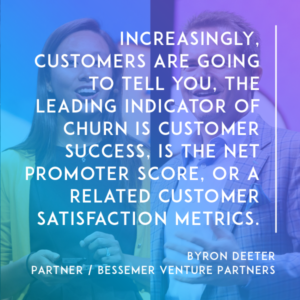
Number five, NPS Everything. It doesn’t need to be Net Promoter Score specifically. It can be any one of the multitude of survey tools and products, but the concept is the same. Ask, and increasingly, customers are going to tell you, the leading indicator of churn is customer success, is the Net Promoter Score, or is related customer satisfaction metrics.
Your customer success team needs to be instrumented with these insights and these tools to be effective.
The other side of this coin, the right side of this chart is the employee side and this is the one that’s just starting to come up and people are just starting to realize that the other critical element of long term value creation is employee churn.
This knowledge workers that are building the foundation of your business and where’s their head at with regard to your company, their manager, their career progression, etc. The majority of people in this room and, in fact, to the majority of people in the workforce at large, are millennials, born 1980 and beyond. Very demanding, very high performing, and also, on balance, short tenured.
Over 90 percent of them don’t expect to stay around to see their first chunk of equity vest over the typical four year period. What does that mean? You’ve got to show upward progression, you’ve got to show responsiveness to issues and you’ve got to have a management structure in place that rewards, incents, and develops them.
Survey your employees, ask these issues, use anyone of the products out there that are strong here and they will tell you their issues and you can get ahead of it, because it is so much more expensive to hire a net new employee than to retain a great one you already have. That’s a business imperative.
Related to this is the technology UI on top of the products. We talked a little bit about the mobile imperative and we’ve seen this progression from the green screen to the thin client in SaaS, to the browser client or the thin screen. With mobility, it’s the small screen and we’re introducing today the concept of screenless, screenless software.
You see it a little bit with the Apple watches, those of you that talk to your cars now. We’re seeing that more and more.
It’s where the graphical user interface actually disappears and whereas an engagement metric is an important sense of value for productivity tools in many cases and time in product, in this case, it’s actually time out of a product or where it’s taking out friction in terms of their engagement.
Our holiday gift to our CEOs this year was hundreds of these Google Home devices. One, because they’re cool. Two, because it’s great mind candy. It’s a great way for them in their holiday breaks, I did it too, to play around and see what’s coming. You look at Amazon Alexa, eight million of these puppies have sold already.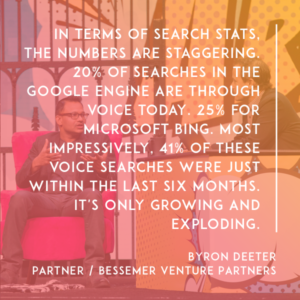
You look at the engagement, and in terms of search stats, the numbers are staggering. 20 percent of searches in the Google engine are through voice today. 25 percent for Microsoft Bing. Most impressively, look at the right. 41 percent of these were just within the last six months, meaning, it’s only growing and exploding.
We are entering an era where different interfaces, and in some case, no graphical interface, is the winning paradigm. You combine in that with AI and APIs and some of the other trends. Smart software starts to become a pervasive part of the world in which we live.
To execute on this, I’m going to leave you with one thought which is the one prediction that we’re repeating from last year, which we think is particularly relevant in this environment, in this day and age, which is around team strength and team diversity.
Now, independent of your social or political views, and as Bessemer American venture partners in the firm, we put out a very clear statement on this with regard to that and we support our companies that do, but simply for business reasons, look at the data. A majority of the billion dollar companies that you want to be part of, that we want to invest in, are founded by diverse teams.
Gender diversity makes a company better. On the right hand side, look at the stats cultural, ethnic, religious, gender, etc. Those are the businesses that we as a global firm want to back and looking at the SaaStr lineup, over 2000 attendees were international, which for us is absolutely awesome because you’re living it and you’re benefiting from it.
You can buy in the team dynamic with the technical advantages with some of these forward looking opportunities around AI, around leveraging other people’s services and software in the API world, and architecting for scale with infinite objectives but not infinite cost, and you start to unlock a lot of the valuable elements here that we list in the other predictions.
In the words of Jeff Lawson who spoke on stage yesterday, Twilio founder who we’ve been fortunate to back, at Bessemer, we can’t wait to see what you’re going to build. Keep kicking ass. Thank you.
You can view the slides here.

